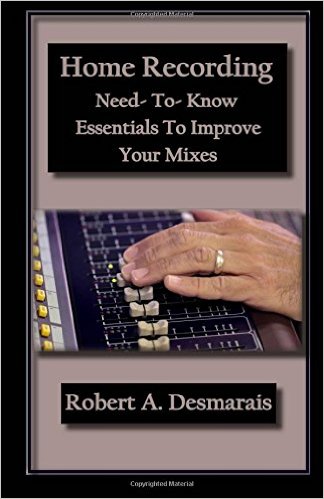The following tutorial, How To Set A Compressor, is reprinted from the book “Home Recording Need-To-Know Essentials To Improve Your Mixes“.
How To Set A Compressor
So, let’s assume we have an unruly vocal track; one that is too loud in certain areas of a song, and/or too soft in others, or perhaps there’s one verse or chorus where it just gets too loud. There are several ways regarding how to set a compressor, but the way I set my compressor on a vocal track is like this:
- Choose a softer passage and set the fader so the volume level is appropriate (i.e. the vocal track sits well in the mix from a dynamics standpoint).
- Go to a louder passage and listen. Are the vocals too loud? If so, we know how to fix this; add a compressor as an insert effect on the track. The compressor will reduce the gain and make the loud part sit better in the mix.
- Set the ratio at a conservative 3:1 to start.
- Move the threshold setting to zero, and slowly start bringing it down. Bring it down until gain reduction occurs; then more until the loud passage sits well in the mix.
Great! You have compressed the vocal so that the loud passage sits well. Now, go back to the softer passage. Is it still OK? If so, and chances are if the threshold was set correctly it is, listen through the mix, and all may be well, with just some minor tweaks required. But if not, now what? How do we get both the loud and soft passages to be at appropriate dynamic levels with a single threshold setting? We’ll do that through our ratio setting, and here’s how you fix it:
- Go back to the softer passage. You should be seeing gain reduction, which is why it’s no longer sitting well in the mix. Slowly increase your threshold so that the dynamic level is back to sitting well in the mix. You should now see little, if any gain reduction occurring – but listen before looking!
- Now go back to the louder passage, which at this point should be too loud due to our increasing the threshold (hence less source getting compressed). There should still be some gain reduction going on, just not enough. Now is when we’ll increase our ratio. We were at 3:1.. don’t be afraid to go to 6:1 or 8:1.. whatever is needed to get the louder section to sit well. You may need to tweak the threshold a bit, and if you do, make sure to go back to the softer passage and tweak as needed.
Are you interested in learning more and improving your mixes? Order “Home Recording Need-To-Know Essentials To Improve Your Mixes“.
Combined with downloadable online tutorial files and helpful checklists, and over 25 illustrations to help to make even difficult concepts easy to understand, this 110-page book is by far the best home recording book for beginners, and is priced at just $9.99!
Topics covered include:
- Understand the impact your room has on your recording and mixes, and what you need to do to properly treat your space.
- Need-to-know essentials so that you spend your limited budget on the most impactful hardware.
- Understanding the difference between using insert vs. send to patch effects; illustrations will clarify these two methods for you.
- Understanding when and why you need to use compression.
- Audio Compressor Basics: A simple approach to understanding the threshold setting on compressors and gates.
- Details on how to set a compressor.
- How to high pass filter, and why it’s your most powerful mixing tool.
- Advanced mixing techniques: serial and parallel compression, using distortion, multing, and comping.
- Links to downloadable Mixing, Critical Listening, and Recording Session checklists to organize your workflow!
Order HERE!

